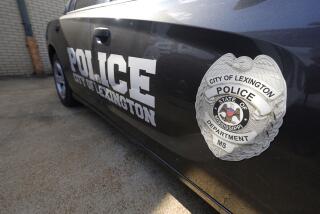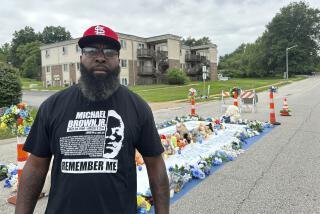In St. Louis, Criminals Who Once Ran Now Use Their Guns
- Share via
ST. LOUIS — On the streets, word is, it’s open season on the cops.
In the last eight weeks, four St. Louis police officers have been shot at -- not in violent struggles with wanted criminals, but in everyday stops. The kind of work that used to be called routine.
One was fired on when he tried to pull a driver over on a traffic violation.
Another drew gunfire as he responded to a suspicious-person call by pulling over to speak with a pedestrian.
A third officer was shot in the groin when she arrived on the scene of a minor car accident.
And just last week, an officer was ambushed in an alley as he pursued a driver who had been steering erratically. The officer was hit twice in the back and once in the arm; the ring finger of his right hand was nearly severed.
So far this year, St. Louis cops have been shot at 37 times. Adjust that for the size of the department, and that means police are fired on here at least as often as they are in Los Angeles.
It’s not the rising numbers that scare the beat cops. It’s the recognition that more and more of these armed assaults are unprovoked and unpredictable. And becoming almost, alarmingly, routine.
“It used to be that criminals would jump out of their cars and run away when we tried to apprehend them,” said Officer Gary Wiegert, a 22-year veteran. “Now, they don’t bother to run. They just shoot at us.”
On the worn streets of a ragged north side neighborhood, 30-year-old Ben Escobar jams his hands in the pockets of his leather jacket and shrugs his indifference.
“People got to do what they got to do,” he says.
And then explains: “People are tired of the police harassing them.”
His friend, a wiry man with gold-rimmed glasses, nods. “If you got a burn on you, you might as well put it down on them, because they’re going to shoot you if they see it,” he says. Translation: If you have a gun, and an officer spots it, you might as well go down in a blaze of glory. It is the bluster of a man with nothing left to lose.
And it is echoing, all too often, down the streets of this city’s poorest neighborhoods, as a blood-soaked bravado takes hold among the rotting abandoned buildings and weed-tangled vacant lots.
For the last several years, this city of 348,000 has had one of the nation’s highest urban crime rates, according to Eli Lehrer, a policing expert at the American Enterprise Institute. That statistic takes into account violent and nonviolent crimes, including larceny. Though homicides are significantly down in St. Louis this year, rival gangs shoot back and forth, ever more brazen. Last month, one group opened fire at a foe across Interstate 55, raking rush-hour traffic.
Over the summer, officers were drawn into at least four gun battles with suspects. One such free-for-all -- between suspected gang members and police in unmarked cars -- left a 17-year-old boy dead in an alley, shot in the back by an officer.
“We have war,” said Sam Moore, a civilian who works with gang members. “To these kids, the police are the enemy.”
In response to the violence, Police Chief Joe Mokwa last month ordered his 1,100 officers to wear bulletproof vests while on duty. But some cops say that’s hardly a solution.
Echoing police in other cities -- most notably Cincinnati, where cop-civilian tension erupted into riots in April 2001 -- some officers complain that they have been “shackled” by department policies and local ordinances.
Wiegert, the police union president, complains about a requirement that officers report the race of each suspect they stop. That policy is designed to halt racial profiling. Wiegert contends that it makes cops timid. Arrests in south St. Louis plunged 21% in the nine months after the requirement was enacted, he said, because officers were wary about being labeled racist.
Wiegert is equally concerned about Mokwa’s new pursuit policy, which calls for officers to chase a stolen vehicle only if they believe that the suspects are dangerous. Wiegert fumes that it only makes police look impotent -- emboldening the bad guys.
“I don’t think ‘run and hide’ was part of our oath,” a frustrated officer wrote the other day on an Internet bulletin board for local law enforcement.
In the city’s most troubled neighborhoods, young African American men say police aren’t backing off -- they’re lashing out. They talk of officers ordering them off the street corners where they hang out with friends, of being forced to lie spread-eagled on the ground.
But some youths do welcome the stepped-up patrols, including an all-out effort to disarm thugs. Police have seized at least 380 illegal weapons in the last six months.
“It’s cool,” said 18-year-old Rasheed Smith. “They don’t harass you unless you’re doing something wrong. As long as they know your face, they’re not going to stop you.”
But a few blocks away, waiting for customers at a dilapidated carwash, Kevin Robinson, 45, fears more hostilities. “Things have been building up,” he said. The edgy atmosphere here in many ways mirrors the tension that exploded into race riots in Cincinnati a year and half ago.
There are some key differences. The riots erupted after Cincinnati police shot an unarmed black man -- the 15th African American suspect killed by officers since 1995. St. Louis police have used deadly force far less often. Also, many blacks in Cincinnati had distrusted police for years, contending that the department was riddled with racist, brutal officers. In contrast, former St. Louis Police Chief Clarence Harmon, who is black, was so popular that voters elected him mayor in 1997.
Still, frustration among citizens has been mounting. While other cities have seen a big drop in crime in recent years, the improvements in St. Louis have been far more modest. From 1995 through 2001, the crime rate in major cities dropped about 30%. St. Louis’ reduction was just 7%, according to Lehrer.
Adding to the tension, community activists have been struggling for years to set up a civilian review board to monitor the police. The officers’ union adamantly opposes such a board. And so far, politicians have been cautious about pushing it.
A group calling itself the Coalition Against Police Crimes and Repression has threatened a boycott of St. Louis convention sites unless a review board is in place by spring. A similar tactic in Cincinnati has succeeded in keeping away a number of big-name entertainers and groups, from Bill Cosby to the National Urban League.
Such pressure tends to “keep the pot bubbling,” escalating tension between police and civilians, said James Gilsinan, dean of the St. Louis University College of Public Service. Still, he discounts the idea that cops have become targets. While it may be tempting to see a trend in the recent shootings of officers, he views each case as distinct, the timing as coincidence.
Jeanette Culpepper would like to agree. She can’t.
Just a few weeks ago, she was walking down the sidewalk outside her home when Officer Christine Fernandez drove up in a police cruiser, responding to reports of a two-car crash. As Fernandez got out of her car to talk to the drivers, one of them pulled a handgun from his waistband and opened fire. A bullet hit the young officer’s groin. Fernandez fired back at her assailant, hitting him in both legs. Detectives later followed a bloody trail to the suspect, who was arrested and charged assault. Fernandez is recovering and hopes to return to patrol. “If I hadn’t seen it for myself, I wouldn’t have believed it,” said Culpepper, who heads a group called Families Advocating Safe Streets. “Something is definitely wrong. Trust me, a pot has boiled over.”
More to Read
Sign up for Essential California
The most important California stories and recommendations in your inbox every morning.
You may occasionally receive promotional content from the Los Angeles Times.










